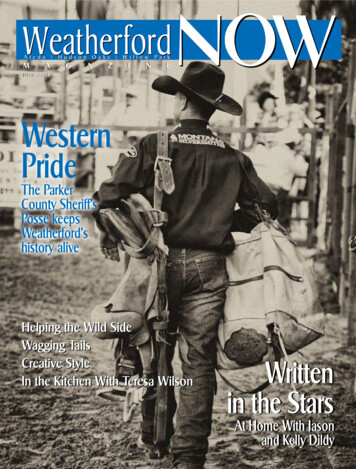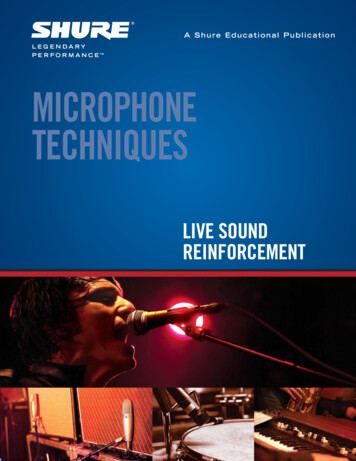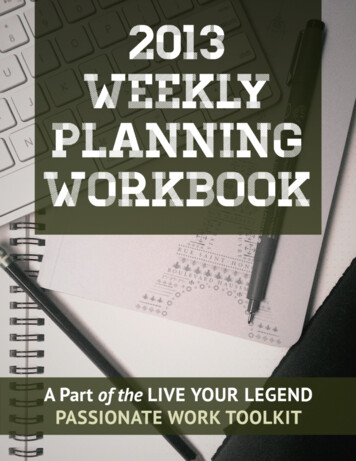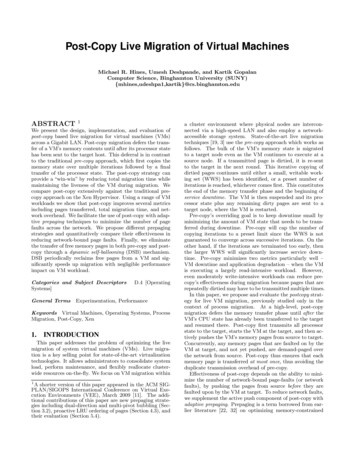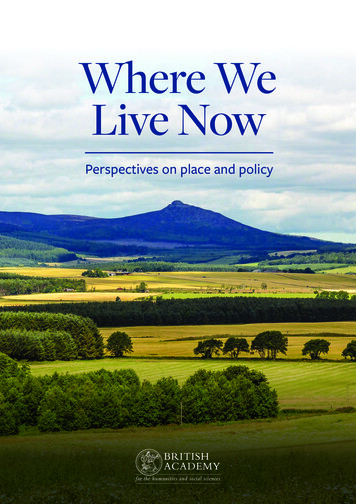
Transcription
Where WeLive NowPerspectives on place and policy
The British Academy is the UK's national body for thehumanities and social sciences – the study of peoples,cultures and societies, past, present and future.We have three principal roles: as an independentFellowship of world-leading scholars and researchers;a Funding Body that supports new research, nationallyand internationally; and a Forum for debate andengagement – a voice that champions the humanitiesand social sciences.Published 2017The British Academy10-11 Carlton House TerraceLondon SW1Y 5AH 44 (0)20 7969 5200www.britac.ac.ukRegistered Charity:Number 233176britac newsTheBritishAcademyBritacfilmBritishAcademy
ContentsPreface2What is place? The sense and feel of place3Phenomenology and place, or: feeling that you live somewhere4Billia Croo, Alec Finlay8Fiona Reynolds and Deborah LambJo VergunstCommentary by Heather H. YeungHoming Instincts and the mediation of screen space10How to capture – and create – place and ‘placeness’?14The Hidden Gardens, Gerry Loose20Case study: Pope’s Urn: Twickenham22Understanding place: its impact on people and relationships23Where we live now – why does it matter for our mental health24Turnings, Patrick BondThe geographies of ethnicity and religion in contemporary Britain:how divided?2829Social Media, Place and Policy37Shaping where we live for the better: practical approaches41Making sense of the place in which we live: ‘more than a feeling!’42Case study: Waterways & Local Places47Landscaping Change: Exploring the transformation, reconstitution anddisruption of environments through the arts, humanities and social sciences52The Bindings, Patrick BondCase study: How the crowd is taking ownership of place, policy and opportunity5657Case study: People, Place and Collaborative Research59Ian ChristieRuth FinneganCommentary by Heather H. YeungIsobel ColchesterSarah CurtisRon Johnston, Richard Harris, Kelvyn Jones and David ManleyMark BirkinDenise HewlettHeather ClarkeSamantha WaltonJess Ratty and Jason NuttallMaria Adebowale-Schwarte
2Where We Live NowPrefaceThroughout 2016 the British Academyhas been exploring the nature of place:what it means to people, how it featuresin policy making and whether it might bemore useful than it currently is as a wayof thinking and planning for the future.We have held workshops in four locations around thecountry, public debates, and discussions within ourFellowship and the academic community.We've been astonished by the enthusiasm and diversity ofpeople's responses to the idea of giving place much moreprominence. This project has occurred at a point when theidea of place has been gaining ground in mainstream agendas;an idea which offers new perspectives and potentially lifechanging ways of looking at the world and improving people'swellbeing.Our conclusions from this exercise are published in anaccompanying volume to this publication which sets outboth the case for better place-based policy making andsome practical ideas for taking it forward. The chapters inthis document provide yet further evidence of the enhancedinsights and perspectives that can be derived from looking atissues from a place-based perspective.In chapters as varied as Ruth Finnegan's literary journeythrough place and Denise Hewlett's analysis of therelationship between tranquillity, quality of life and place;to Jess Ratty and Jason Nuttal's lively case study of howcommunities engage with place through crowdfunding; andHeather Clark's work on waterways as place-makers, wesee how academic and policy-related studies are enhancedby using the lens of place. Moreover, as Ron Johnston'sexploration of the politics of place and new communitiesexperiencing immigration, and Sarah Curtis' analysis ofthe impact of place on mental health demonstrate, theseare cutting edge issues which need modern solutions. Thechapters are interwoven with poetry and artwork drawing onthe inspiration of place, and continually reinforce the messagethat we would all benefit from taking the notion of 'place' moreseriously. In doing so, they also illustrate the diversity of placesand people's responses to them, and that taking account of thisin policy can help us better meet people's needs.We commend these chapters to you, and encourage you toread them in tandem with the reports of our workshops inManchester, Cornwall, Cardiff and London, and with our policydocument, The case for place-based policy, which argues forbringing place into the heart of policy and decision-making.We thank our authors warmly for their input, and the policyteam at the British Academy – especially Jamiesha Majevadia –who worked so hard on the project.Joint Project Chairs, Where We Live NowDame Fiona Reynolds hon FBAMaster, Emmanuel College, CambridgeDeborah LambDeputy Chief Executive, English Heritage
3What is place?The sense andfeel of place
4Where We Live NowDr Jo Vergunst, Lecturer in Anthropology, University of AberdeenPhenomenology and place, or:feeling that you live somewherePhenomenology is a philosophy ofexperience and perception. In mydiscipline of social anthropology, itcreates rich and detailed accounts ofplaces as they are lived in. It exploreshow places are made and re-madefrom an insider’s point of view.It encourages deep questions: How do people perceive and come toknow the places they are in? What does it mean for a place to be inhabited? What is the significance of a direct,unmediated experience of a place, orin other words, how it actually feels tolive somewhere?These are questions that might loosenup our thinking.Imagine a place, even a room, that you know well;let us say your bedroom. It is almost completely dark, butyou need to get up out of bed. You find that you are ableto do so very quietly, without being able to see, and withouthitting anything. Indeed, if you are still imagining, you couldrecreate how you reach out your arm across the darknessto reach the door handle very precisely – there is no needto search for it across the wall. Somehow your body knowsthe room intimately, its distances, its obstacles and how itaffords your passage through it, without your mind reallythinking about it. You are still half asleep of course, andperhaps hardly thinking at all.I am inspired in this small thought experiment byphilosopher Gaston Bachelard’s book The Poetics of Space.Bachelard uses the term ‘muscular consciousness’ to conveyhow the body knows where it is and how to move around.His book is also a phenomenology of poetic images. Heinvites us to daydream our way through a house where,he writes, ‘imagination, memory and perception exchangefunctions. The image is created through co-operationbetween the real and unreal’.Consider how you feel differently in a cellar, a kitchen, thebedroom you have just thought about, or an attic. what isit that becomes real in those places for you, or for someoneelse? Perhaps these are just insubstantial ‘images’ in yourmind, but for Bachelard, ‘phenomenology of the imagination(.) demands that images be lived directly, that they be takenas sudden events in life.’ “The feelings we have about placesare also an aspect of their reality. ”
5What is place? The sense and feel of placeThen, if you like, think about how anthropologist John Knightdescribes family houses in rural upland Japan (in Rival’s bookThe Social Life of Trees). Trees are grown specifically toenable the periodic re-building of the house that sustains itas a family home. The growing tree is thought of as a childthat reaches maturity, and when it is felled, may begin its‘work’ as house timbers. The growth of human children in thefamily house in turn creates labour for forestry, and so thecycle of forest-house-forest continues. For some of Knight’sfieldwork informants, however, the recent practice of buildinghouses in concrete denies the trees the ‘second life’ to whichthey are due. From a phenomenological perspective, theserelationships are not just symbolic in the sense that the housemight represent the landscape and the family. They also entaila practical and ethical stance towards place, involving living withtrees appropriately, that is at the same time imagined and real.A place is not an object that can be completely describedand measured. Its phenomenal qualities – the ways in whichthe place is for you as a perceptible entity – might be quitedifferent and diverse, and the way you perceive a place willdepend on the intentions you have in relation to it: Are you trying to move through it? Find something in it? Even change or develop it, perhaps as a planner? Or simply inhabit it safely and securely?Intentionality brings the experience of place into a relationwith ideas of time – the past, present and in particular thefuture, in terms of what they place might still become andwhat a person or thing might be as part of it. And yet, thephenomenology of place is not simply an account of howsubjective experience contrasts to the objective. It is rather anexploration of the grounds of experience and perception thatgive rise to subjectivities in the first place.We need some specific language to get to grips with theseexperiences of place. Another philosopher, Martin Heidegger,gives us some key words: “Heidegger was interested in‘being-in-the-world’, or how things are, within their placesof phenomenal existence, rather than how they can beconstructed in the abstract or in an ideal form. ”The Social Life of TreesIt invokes the significance of direct experience andperception, so perception always happens in regard tosomething, and we are conscious of our own world and notmerely conscious or perceiving beings in general. Or try‘unconcealment’, which is the process by which things revealtheir form of being to us. One of Heidegger’s examples isa ceramic jug, whose being-in-the-world, he writes, is as a‘void that holds’. So as a jug holds water, and pours it outsometimes, it is unconcealing itself. A jug in a museum cabinetthat is never used, although it may be looked at, cannot revealits being in the same way.How do places reveal or conceal themselves?Amongst the Foi of Papua New Guinea, according to JamesWeiner, a place in the jungle is revealed for what it is by afather telling a son its name, which means he has the rightto make a garden there. Weiner argues that this namingprocess does not simply change the ownership of a placebut actually brings it into being for what it is. This is also akey insight of phenomenology – that places are not just pregiven in the world but are constantly becoming themselves.The names of Foi gardens will be revealed to some and leftconcealed from others, and so the place is made presentfor some but not all. We might say that ways of perceivingplaces are learned and shared, whether that involvesfollowing traces left by others, having things of significancepointed out, or listening to stories of place and coming intime to reflect on their meaning. But who hears and learnsis partial – and political.So here is another story. Imagine that the bedroomyou thought of a little while ago was not your own inthe present time, but a room from long ago.“ The phenomenology of place is notsimply an account of how subjectiveexperience contrasts to the objective.It is rather an exploration of the groundsof experience and perception that giverise to subjectivities in the first place. ”The Foi people of Papua New Guinea
6Where We Live NowBennachie, AberdeenshireThe particular room I have in mind is in a small croft housebuilt in the early nineteenth century on the side of a hillcalled Bennachie in rural Aberdeenshire in north eastScotland. It is the dwelling of a poor family, with just akitchen and a bedroom, made of granite quarried from thehill itself and a floor of hard packed earth, but with a fineoutlook down the hillside and across the farmed landscapebeyond. It is also a long time since anybody lived there andall that remains now are the lower courses of the stonewalls protruding through the grass, bracken and heatheraround it. Around and about are tree stumps from a forestryplantation grown since the crofters left and now in turnpartially felled. In 1859, the surrounding proprietors gainedapproval for the division of the hill of Bennachie from Courtof Session in Edinburgh.A couple of years ago I helped with an archaeological dighere as part of a community research project. Evidencefrom the archives and local stories described how theresidents of the collection of Bennachie crofts known as the‘Colony’ set up their homes – working together to erect ahouse in a day, followed by a celebration at night – on whatwas understood as common land.“ Evidence from the archives and localstories described how the residentsof the collection of Bennachie croftsknown as the ‘Colony’ set up theirhomes – working together to erect ahouse in a day.”The settlers became rent-paying tenants, and as so oftenwas the way, rents were increased, other events took theirtoll, and the Colony dwindled. But on the old earthen floorunder the tumbled granite blocks in this house (as heavyfor us to carry out as they would have been to build up), wefound smashed plates, a brown teapot also in pieces, andother belongings of the family who must have been rapidlyevicted before the gables of the house were pushed inwards.It was not necessarily remarkable for nineteenth centuryrural archaeology in Scotland, but to take part in the digwas a powerful experience. Somehow we could inhabit thehouse and the wider landscape differently in recognisingthe violence that ended the house’s life as a dwelling firsttime around. Its life is now archaeological, which could, ifyou want, be a tale of how changing economies and classrelationships conspired against the family. But it is alsoa story in itself of smashed plates and collapsing walls asstone quarried from the hill returns again to it. In parts ofthe Colony, little stands of trees grown by the crofters –holly, laurel, cherry, rowan – somehow surv
How to capture – and create – place and ‘placeness’? 14. Ruth Finnegan. The Hidden Gardens, Gerry Loose 20. Commentary by Heather H. Yeung. Case study: Pope’s Urn: Twickenham 22. Isobel Colchester. Understanding place: its impact on people and relationships. 23 Where we live now – why does it matter for our mental health 24. Sarah .
